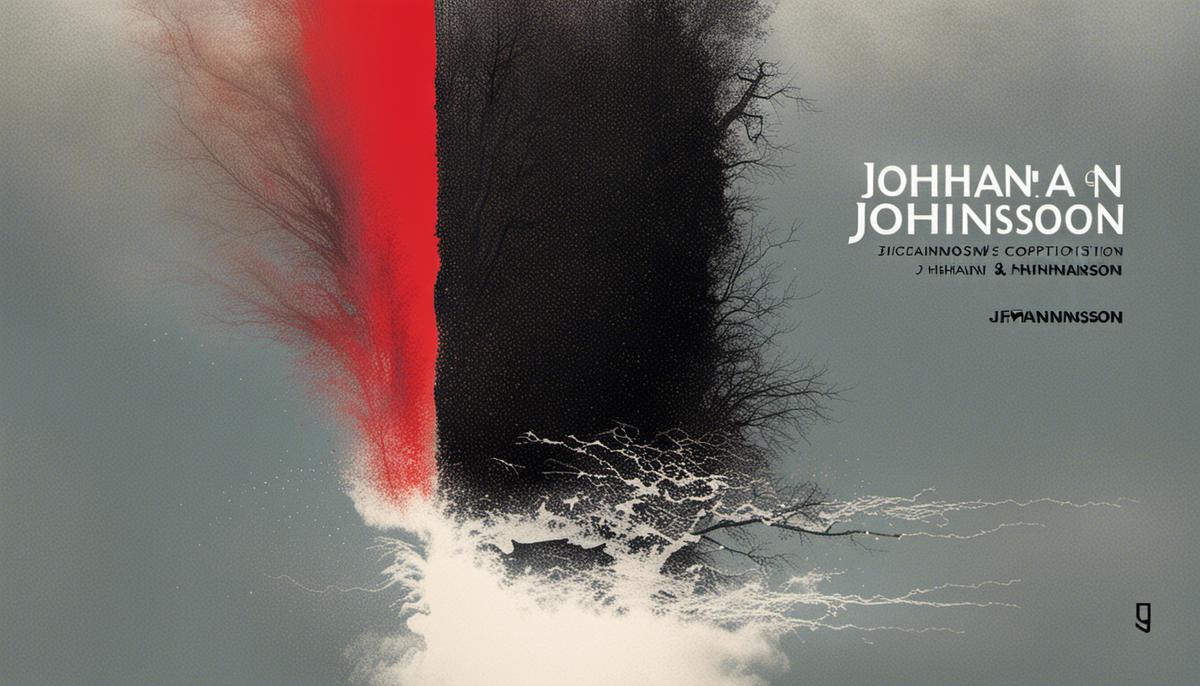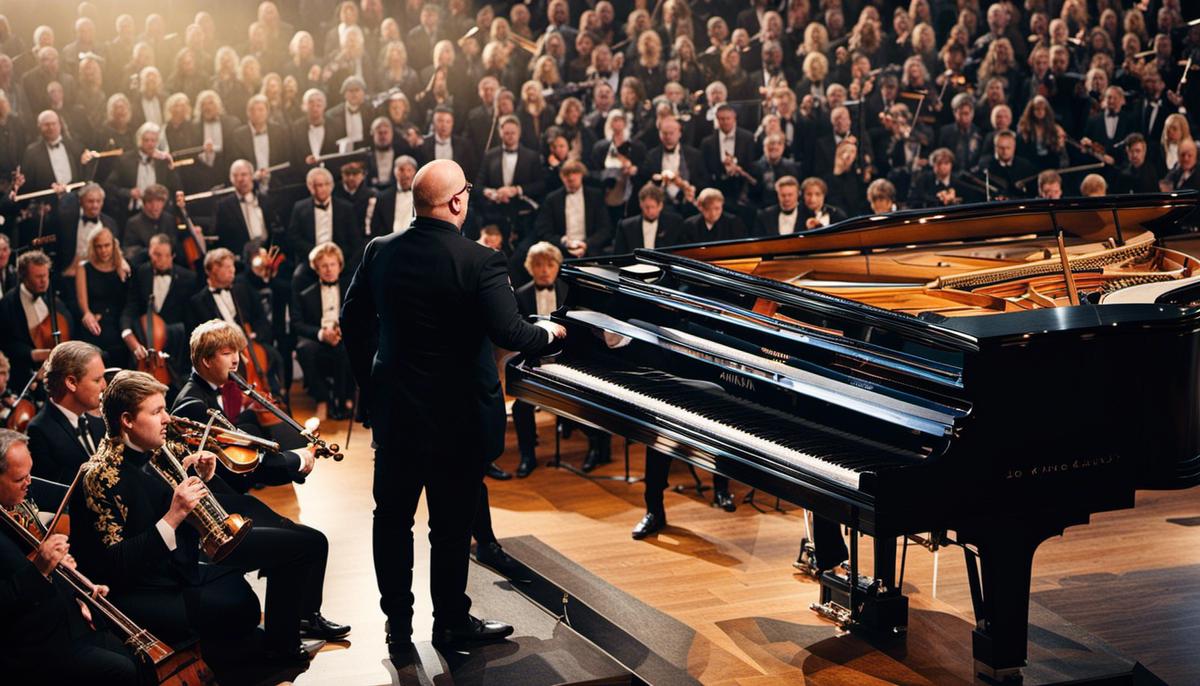Table of Contents
Introduction
The world of music has been graced by numerous icons who, with their unique styles and compositions, have made indelible impressions on the industry. Among these composers, few are as unique and profound as Jóhann Jóhannsson, an Icelandic virtuoso whose breathtaking fusion of classical, electronic, and alternative music has captivated audiences globally.
His distinctive style – richly anchored in his Icelandic roots – has not only set him apart but has also served to open an entirely new soundscape in the realm of music composition. This piece aims to explore his intriguing life and the influential career, dissecting his singular composing style, delving into his popular compositions, understanding the integral elements of his style, and examining the impact and influence of his works posthumously.
Life and Career of Jóhann Jóhannsson
Jóhann Jóhannsson
Jóhann Jóhannsson, born September 19, 1969, was an acclaimed Icelandic composer and musician whose work encompassed a broad range of genres, including classical, electronic, and film scores. His unique sound blended elements of minimalist orchestration with advancements in electronic music.
Early Career
Jóhannsson’s initial foray into music was in the late 1980s with a rock band called Daisy Hill Puppy Farm. Over the next decade, he was part of several indie rock bands and started experimenting, blending rock with electronics. His first solo album, “Englabörn,” combining strings and electronics, was released in 2002 for which he received critical acclaim.
Major Accomplishments
In terms of his major accomplishments, Jóhannsson scored numerous award-winning films. He first gained international attention for his score for “Prisoners” in 2013. His work on “The Theory of Everything,” a biography of physicist Stephen Hawking, won a Golden Globe for Best Original Score and was nominated for the same category at the Academy Awards.
Arguably, his most famous compositions were part of his collaboration with director Denis Villeneuve. His dismal and unsettling soundscapes in “Sicario” were recognized by both the Academy and the BAFTAs. The haunting, minimalist techno score for “Arrival” further cemented his reputation as an innovative composer.
Unique Style
Jóhannsson’s rise to global prominence was a result of both his unique style and his ability to blend various musical genres seamlessly. His compositions often bridged the gap between traditional orchestration and electronic sound manipulation, creating immersive, emotionally resonant scores. Jóhannsson’s music was noted for its evocative, storytelling quality.
His music was characteristically minimalist, focusing on repetition and gradual change rather than development and motion. Jóhannsson made extensive use of drones and textures created from processing recorded acoustic instruments digitally. His approach to composition was also influenced by his fondness for outdated musical and technological forms.
Incorporating Narrative
Jóhannsson would also frequently incorporate voice and text into his work, a reflection of his interest in narrative, whether real or imagined. His incorporation of narrative elements added an extra layer of depth and intrigue to his compositions.
The Eternal Echo of Jóhann Jóhannsson
Despite his untimely passing in 2018, Jóhann Jóhannsson’s impact on contemporary music reremains profound. His innovative approach to composition, fused with profoundly emotional narratives and pensive themes, solidified his perennial legacy in film scoring and beyond. Jóhannsson’s creative genius and lasting contributions persistently motivate aspiring composers and musical enthusiasts.
Jóhannsson’s Unique Composing Style
Mastering Jóhann Jóhannsson’s Composite Music Styles
Primarily, Jóhann Jóhannsson’s music is acclaimed for its harmonious amalgamation of classical, electronic, and avant-garde styles. His compositions break barriers of conventionality, blending various musical elements fluidly. Noteworthy compositions exemplify his talent in pairing orchestral scores with complex electronic echoes and minimalist beats. The result is an enigmatic yet compelling musical journey. Many critics and listeners view his work as a symbiosis of past and present, merging the grace and charm of classical music with the edgy and modern feel of today’s electronic and alternative tunes.
Influence of Icelandic Roots on Jóhannsson’s Music
Jóhannsson’s Icelandic background has heavily influenced his musical style. He had always acknowledged the profound impact of the stunning landscapes and mystic charm of his homeland on his music. The isolated serenity of Iceland as well as its turbulent weather patterns found their way into his compositions, adding a sense of haunting beauty and ambient drama.
Icelandic music, by tradition, incorporates a rich intertwining of storytelling and melody, and Johannsson adapted this in his score construction. His work often constructs a narrative, with each note and rhythm adding momentum to the story.
Evocative Soundscape and Emotional Resonance of Jóhannsson’s Compositions
Jóhannsson’s music is particularly noted for its ability to resonate emotionally with listeners. Rather than focusing on explicit melodies, Jóhannsson’s work emphasizes texture, timbre, and the color of sound. This technique makes his music audibly rich and thematically layered.
He employed an array of instruments and sound elements like strings, piano, electronic synths, and vocals, intricately woven together to form an evocative soundscape. His compositions for films like “The Theory of Everything”, “Arrival” and “Sicario” have been praised for enhancing the emotional power of the visuals with their deeply affective musical narratives.
Jóhannsson’s Minimalistic Approach in his Compositions
To the listener, Jóhannsson’s music may appear minimalistic and simplistic; however, upon close examination, it reveals a high degree of intricacy and sophistication. His scores are characterized by minimal melodies and modest harmonies but the way he manipulates them adds deep nuances to the sound. He would often take a simple melody or musical phrase and rearrange or repeat it, altering the sound slightly each time.
Though the base melody may remain the same, the gradual introduction of new layers adds complexity and emotional depth. This approach creates a richly textured and hypnotic auditory experience.
Delving into Jóhannsson’s Ingenious Use of Musique Concrète Techniques
One of Jóhannsson’s remarkable traits was his inventive use of the musique concrète technique – manipulating raw sounds to illuminate an auditory collage. An embodiment of this method is evident in ‘IBM 1401 – A User’s Manual’, where he produced music by modifying the sounds of an ancient IBM mainframe computer.
This unique explorative approach to music design, harnessing everyday sounds and weaving them into his compositions, cemented Jóhannsson’s name amongst the most acclaimed contemporary composers of his era.
Popular Compositions
‘The Miners’ Hymns’: An Artful Blend of Heritage and Modernity
‘The Miners’ Hymns’, penned by Jóhannsson, is a poignant ode to Northeast England’s venerable, yet resilient mining communities. Juxtaposing brass band orchestration with electronic elements, he created a grand sonic collage. In collaboration with filmmaker Bill Morrison, they unveiled a visual history, amalgamating the industry’s illustrious legacy with its stark realities. The composition’s mesmerizing fusion of melody and contrast encapsulates Jóhannsson’s unique narrative approach to his musical compositions.
Fordlandia: A Sonic Narrative of Failed Utopian Dreams
Fordlandia was one elusive project by industrialist Henry Ford to cultivate rubber in the Amazon Rainforest, which ended unsuccessfully. Jóhannsson’s ‘Fordlandia’ composition is an attempt to narrate this ambition and failure through a blend of classical orchestration and ambient electronics. Full of strong melodic motifs and thematic contrasts, it’s a truly signature piece of his composing style. Its majestic opening, growing in intensity with layered string section, is characteristic of Jóhannsson’s ability to balance orchestra with subtle electronic soundscapes.
Arrival: Incorporating Voicing and Rhythmic Tensions
Jóhannsson’s work in the science fiction movie ‘Arrival’ illustrates his skill in the use of voicing and rhythmic tensions. The opening track, ‘Heptapod B,’ blends orchestral elements with electronic sounds and human voice, creating a strong atmospheric presence. The extraterrestrial communication theme of the film is beautifully supported by the unique sound design and non-linear structure of his compositions in the soundtrack.
Sicario: A Tense and Threatening Soundtrack
For the crime thriller ‘Sicario’, Jóhannsson created a score accommodating the movie’s tension and threatening atmosphere. He colored the soundtrack with an array of tense bass notes, reverberating percussions, and eerie strings. The score notably carries a monochromatic style, maintaining an understated yet constant intensity, a significant feature of Jóhannsson’s style.
Deciphering Johann Jóhannsson’s Unique Composing Style
With his compositions, Jóhann Jóhannsson affirms his one-of-a-kind approach to composing, a distinctive blend of time-honored orchestration and edgy electronic music. His narratives are woven into the fabric of the music, creating works with an intensity that mirrors differing thematic elements’ tonal disparities. Jóhannsson’s signatures include the use of recurring elements and creating suspense. He commands a unique orchestration style, marrying traditional repertoire with synthesized tones, effectively bridging the classical and ambient electronic genres.
His adroit utilization of the human voice as an equally valid instrument, subtly blended into the composition, is a testament to this unique style, as seen in ‘Arrival.’ His compositions shun emotional subtlety journeying through a gamut of moods; from fragile to potent, from solemn to exuberant.

Understanding the Elements of Johannsson’s Style
Mastering the Art of Silence and Repetitive Minimalist Patterns
Johann Jóhannsson’s music illustrates his innate understanding of the impact silence can have by utilizing it to create suspense and provide thematic consistency. He presents silence not simply as an absence of sound but as an instrumental element contributing significantly to the composition itself. This technique’s profound efficacy can be witnessed in the soundtrack for “Arrival,” where silence is used to echo the enormity of space and the ambiguities it contains.
Another component integral to Jóhannsson’s output is repetitive minimalist patterns. These recur throughout his work in the form of constant harmonic loops and rhythmic patterns, resulting in mesmerizing music with a near-hypnotic quality. “The Sun’s Gone Dim and the Sky’s Turned Black” exemplifies this, using a recurring melody against ever-changing electronic backgrounds, subtly drawing listeners into the cyclical nature of the soundscape.
Mastering Complex Orchestration
Jóhannsson’s orchestration skills cannot go unmentioned. He frequently melded electronic elements with acoustic instruments, creating a unique tapestry of sound that was neither purely classical nor electronic. For instance, in his OST for ‘The Theory Of Everything,’ he used an amalgamation of piano, strings, and electronic sounds in a way that was innovative while still being engaging and emotional.
His ability to seamlessly integrate multiple instruments into one cohesive composition illustrates Jóhannsson’s strong understanding of orchestration. Whether it was the strings in ‘Flight from the City’ or the organ in ‘Odi et Amo,’ Jóhannsson managed to create beautiful, intricate layers of sound that felt fluid and interconnected.
Cultivating Melancholy and Hope
Often, Jóhannsson’s music carried a distinct emotive tone that masterfully evoked a sense of melancholy and hope simultaneously. This is particularly evident in the soundtrack for the film ‘Sicario.’ With incremental tempo changes, haunting tonalities, and emotive strings, the soundtrack effectively conveys a collective sense of unease and tension amidst the hopelessness, encapsulating the film’s themes realistically.
Notably, the emotional depth of Jóhann Jóhannsson’s music emanated from his skillful use of repeating patterns, deliberate silences, and robust orchestration – these elements together birthed the unique sound that Jóhannsson’s work is globally noted for. If you dream of replicating his style, it’s crucial to focus on these key aspects: building emotional intensity, utilizing silence as a powerful tool, and demonstrating proficiency in orchestration.
While emulating Jóhannsson’s compositional style isn’t a simple process, comprehending and integrating these elements into your own music-making could bring you a step closer to capturing a semblance of his unique musical signature.
The Impact and Influence of Jóhann Jóhannsson
Style and Noteworthy Compositions
Hailing from the tiny island nation of Iceland, Jóhann Jóhannsson crafted a remarkable place for himself in the music world through his expansive and innovative discography. His unconventional blend of digital ambiance and traditional instrumentation, along with his consistent use of narrative techniques, positioned him as a leading figure in the minimalist and ambient music genre. Jóhannsson’s compositions frequently exhibit a fusion of symphonic components skillfully interwoven with digital alterations and electronics.
The Soundtrack Maestro
Jóhann Jóhannsson’s formidable talent for merging soundtrack and narrative made him a formidable presence in the film industry. He brought an unparalleled sensitivity to his film scores, combining ambient sounds, classical music, and integrated computer-generated effects. His contribution to Denis Villeneuve’s ‘Arrival’ (2016), which earned him an Academy Award nomination, wove in world music and piercing sound design to construct the alien language theme.
Arguably his most acclaimed score came in 2014’s ‘The Theory of Everything’, for which he won a Golden Globe. Jóhannsson’s warm, minimalistic score masterfully portrayed the physical stagnation and intellectual advancement of the film’s subject, Stephen Hawking. The soundtrack is imbued with both a profound sadness and an uplifting spirit.
Influence on Other Musicians
Jóhannsson’s influence on other musicians and composers has been significant. His explorations between minimalist electronic and neo-classical styles have paved the way for other artists who also navigate these genres. His explorative and evocative approach to storytelling in music has inspired a generation of composers including artists like Max Richter, Olafur Arnalds, and Nils Frahm.
It was Jóhannsson’s tendency to experiment and skilfully interweave different musical components that made him a reference point for other artists. His thematic and lyrical concepts have become archetypal for a growing sector of the music industry.
Jóhann Jóhannsson’s Legacy
The untimely death of Jóhann Jóhannsson in 2018 meant the loss of a singular voice in the music industry. His meticulous ability to tell complex stories with music, his explorations of the boundaries of sound, his impact on fellow musicians, and his contribution to film soundtracks constitute a significant legacy.
Although Jóhannsson’s career was cut short, his innovative fusion of classical and electronic music continues to inspire artists around the globe. Despite his departure, the influence of Jóhann Jóhannsson continues to reverberate in the music industry, testifying to the timeless nature of his work and cementing his position as a trailblazer in contemporary music.
Conclusion
The fascinating journey of Jóhann Jóhannsson serves as a testament to the transformative power of music, illustrating how an artist can create a distinctive sound that transcends the ordinary and deeply resonates with listeners. His ingenuity in blending traditional and modern elements continues to inspire contemporary artists, thus securing his standing as a modern-day musical luminary.
Even as we revisit the melancholic beauty of his compositions, it becomes clear that Jóhannsson’s legacy shines brightly against the backdrop of the music industry. His rhythm language, use of silence and minimalist patterns, and complex orchestration, have etched an overarching motif of hope into the landscape of global music. It is in the very notes of his harmonies and the pulse of his rhythm that we find an everlasting echo of Jóhann Jóhannsson’s remarkable musical journey.
Additional Reading
Take some time to check out our other articles:
- Popular Music Industry Careers
- The Metaverse and Music
- 7 Essential Music Production Tools Under $100
- 5 Best Ways To Invest In Music
Breve Music Studios publishes music to Spotify, YouTube Music, Amazon Music and more. Follow our pages on Facebook, Instagram, Twitter, TikTok, and YouTube.
Listen to our ensembles: Breve Orchestra, Breve Music Ensemble, Breve Low Brass Ensemble, Breve Woodwind Ensemble, and Jermaine Harris on Spotify.


4 thoughts on “Exploring Jóhann Jóhannsson’s Melodic Infusions: A Deep Dive (2023)”
Comments are closed.